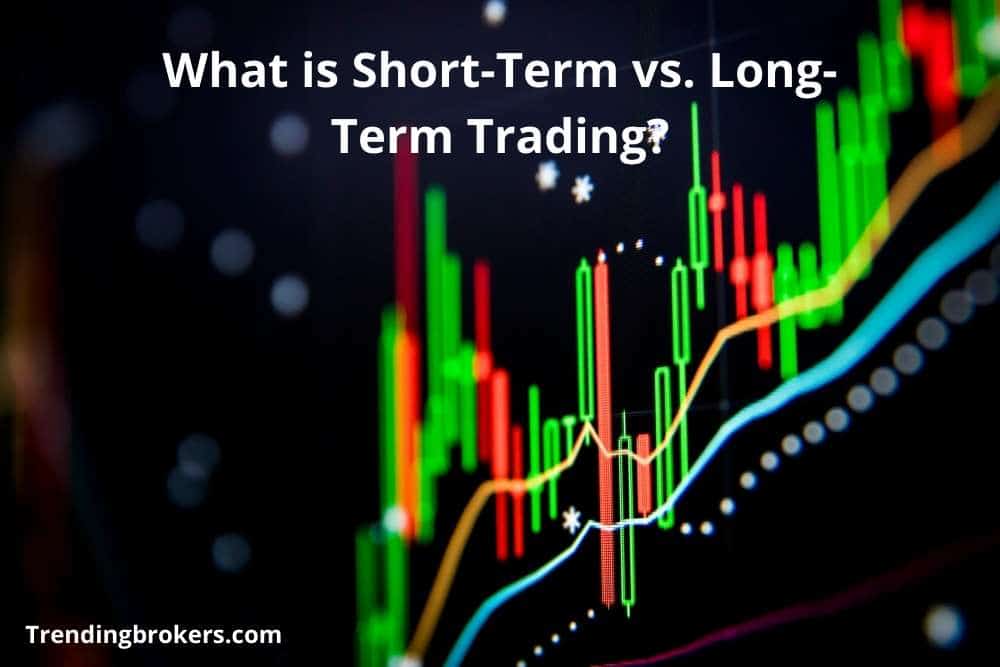Learning all the different components, especially diverse methods, is all we require to become a successful trader. Then, the main decision you have to make is whether you want to focus your time and energy on short-term trading (day trading) or long-term investing.
Both types of trading strategies are perfectly capable of delivering you large sums of profit. Many traders choose to do both simultaneously to balance their investments and money. At least at first, you should consider both before making your decision if you want to focus on only one short-term or long-term.
What is Short-Term Trading?
Short-term trading occurs when the period between purchasing and selling is a day, a few days, or a few weeks. Traders prefer short-term trading for having instant advantages with the rapid price fluctuation.
Advantages
- Making profits faster: This trading strategy benefits a deal very quickly in a short period as the trader can work out immediately with price fluctuations.
- Short-term Risks: If you discover that you made a mistake on a trade, you can free up funds and reinvest them in new assets.
Disadvantages
- Market turbulence: There is a risk of losing a significant amount of money due to volatility.
- Stress: The stock market’s unpredictable character often makes it difficult to anticipate the future status of your capital investment.
- Time-consuming: You must nearly constantly monitor the market to make the appropriate option at the proper time.
What is Long-Term Trading?
Long-term trading is defined as trading where the duration between purchasing and selling is between a few months and a few years. In Long-term Trading, the trader is free to invest and easily observe the market fluctuations for an extended period of time.
Advantages
- Less Stressful: Long-term trading contains less stress because traders have a lot of time to cover all the risks and debts.
- Time Saver: In this strategy, traders can concentrate on various productive tasks and utilize valuable time. Before placing a purchase or sell order, traders have time to analyze stocks and do thorough research.
- Tax Saving: Long-term trading helps traders to save taxes as long term traders have to pay 5% to 15% tax
Disadvantages
- Comprehensive Knowledge: Long-term trading contains the vast knowledge of stocks and shares. For traders, it is tough to imbibe and remember complete knowledge.
- Research: Long-Term trading needs lots of fundamental knowledge, and sometimes traders fail to do so.
- Patience and missing out on chance: Long-term trading requires a capital commitment to be invested for the long term; a good chance trader will miss out on market volatility to make money, and traders have to wait patiently for the next chance.
Short-Term Trading vs. Long-Term Trading
Short-term trading refers to trades conducted for a short period of time and completed in a single day or single week. Traders who use this strategy earn profit from short-term price changes in their trade assets.
These trades can often complete trading matter in minutes or even seconds. They may endure longer in rare situations, but they are constantly opened and closed in a few days.
While, Long-term trading known as investing, entails keeping trades open for significantly more extended periods of time. It can last from month to year. It is a type of trading that falls somewhere between short-term and long-term trading, with real long-term investments lasting months or even years.
Unlike short-term trading employs a buy-and-sell strategy, long-term trades employ a buy-and-hold method. While this may appear straightforwardly at first glance, it is important to note that the decision-making processes for the two are different in many ways, such as Capital Requirements, Expertization, Personality Characteristics, Commitments on time, and returns on Investments. It also necessitates a variety of abilities and even personality qualities.
Nonetheless, both types of trading are vital components of a well-diversified investment strategy. Short-term trades provide lesser profits more quickly, but they demand traders’ active participation and monitoring, whereas long-term transactions produce higher passive income and wealth building.
Let’s look at the distinctions between the two forms of trading and see what each one entails and how it affects the trader’s approach:
1.Capital Requirement
Capital needs are different for both types of trading. You must begin with something when you enter the realm of trading. The goal is to make money, but you’ll need a small amount of money to get started, which is the first key difference between these two tactics resides. Long-Term trading requires a large amount of capital investment, and short-term needs a small amount of capital investment.
If you want to invest in the long-term, your alternatives are a little more limited, and most people go for stocks. For example, they have an expiration date, making them unsuitable for long-term Futures trading. Likewise, you can invest in currencies, but your options are restricted because only a few are both stable and investable.
Meanwhile, there are thousands of stocks and ETFs to pick from, and they may be readily invested in for years if you have the patience to wait for long. The minimum required capital varies depending on your decision, and there is no set amount you must invest. Concentrate on your commissions and educate yourself about your investing assets. If you’re a beginner, start with tiny amounts until you’ve gotten the hang of it.
2.Time Commitments
Another main distinguishing factor between long-term and short-term trading is the amount of time required to invest in the market. Short-Term trading entails opening and closing a trade within a single day or a few days, and Long term trading lasts for a long upto months or years, as previously said.
That involves staying on top of current events, market moves, and anything else that could affect the pricing of the assets you’re trading. If you want to earn money on a daily basis, you’ll need to commit to watching the market every day for a few hours.
The most significant price changes usually occur within the first hour after the markets have officially opened. After that, the price fluctuates for a few hours before stopping as New York lunchtime approaches. So, finally, you should set aside 15 to 40 hours each week to be available for every chance and make the most of the profits out of market condition.
When it comes to long-term trading, it allows you a lot more flexibility because you may do your study at any time and merely monitor the market movements on occasion as you have a lot of time to observe. If you have a day job and can’t afford to continually follow the market, this is a fantastic option to invest in.
Finally, based on the investing strategy you choose, all you need is a few hours per month to browse the stocks and locate the one that fulfils your criteria. Of course, in extreme circumstances, if you’re a so-called set and forget’ investor, you’ll need to perform a smidgeon of study and check on your investment now and again.
3.Personality and Skill Characteristics
Skills and personality qualities may be included in a single point, and it’s simple to see why this is essential in becoming a great trader. You’ll quickly realize why the two trading techniques necessitate distinct abilities and mindsets.
Both types of trading necessitate dedication, as you must conduct research, devote time to studying various techniques and selecting the best one, and so on. Once you’ve decided on a strategy and worked out the details, you’ll need to learn how to put it into action.
For traders, this might be challenging, at least until they master the basics and gain experience. Another challenging concept for inexperienced traders to grasp is the importance of sticking to their strategy and avoiding emotional reactions. Many people do this because the opportunity appears ripe for the taking. However, even if the trigger does not appear, irrational and emotional traders will engage or exit the trade, resulting in capital loss.
Long-term trading necessitates patience, as you must wait years for a profitable return on your investment. This trading requires patience because you must wait for the previously stated criteria to be met before reacting.
Long-term investors are in the same boat since they must wait for a trade trigger to appear before acting. However, because they rarely monitor their positions and fret about every price fluctuation, the desire to trade is not as strong as formerly.
The most important necessity is patience and emotional control because you cannot afford to panic or react until the timing is perfect. Remember this, and you will profit far more frequently than people who ignore such guidelines.
4.Returns on Investment
All the traders decide to do short-term or long-term trading based on returns/profits. Everyone wants to continue with the type of trading which gives good profits and returns.
Many traders consider the possible profits when deciding whether to pursue day trading or long-term investing. Traders have a primary goal to generate money; therefore, they always go with the one that has the best prospective returns.
However, determining which is better because they are entirely different. For example, day trading takes up a lot of your time, but long-term investing takes up very little.
Long-term investments can earn millions with little to no impact on performance. In contrast, short-term traders will experience a decrease or rise in performance even if their account is only a few hundred thousand dollars.
It’s impossible to invest a large amount of money in a trade that lasts only a few minutes, and all of these factors combine to make the two styles of trading very distinct.
As a short-term trader, you might be able to make 0.5 per cent to 3% every day on your capital. While this is a small sum per day, it represents 10% to 60% of your wealth every month, which is significantly better. However, only smaller accounts can expect returns of up to 60%, and as your capital rises, you will gradually move closer to 10%.
Meanwhile, long-term traders should expect to earn an average of 10% every year, but this varies by year, and returns might be substantially greater or lower at times. However, they usually don’t have to do anything other than wait and watch the market’s performance.
Conclusion
Make your own decision. As previously stated, you can do both simultaneously if you want to, or you can focus on one, depending on your free time, investment, personality, and how much effort you want to put in in addition to your money.
Whatever path you select, keep in mind that patience is vital and that allowing your emotions to dominate you can whatever path you select, keep in mind that patience is vital and that allowing your emotions to dominate you can only lead to a mistake — one that might cost you a lot of money, depending on your investment. For both Short-term and Long-Term trading you need a trustworthy broker like PrimeFin, which can give you good returns on your investment.
Read our PrimeFin Review.


